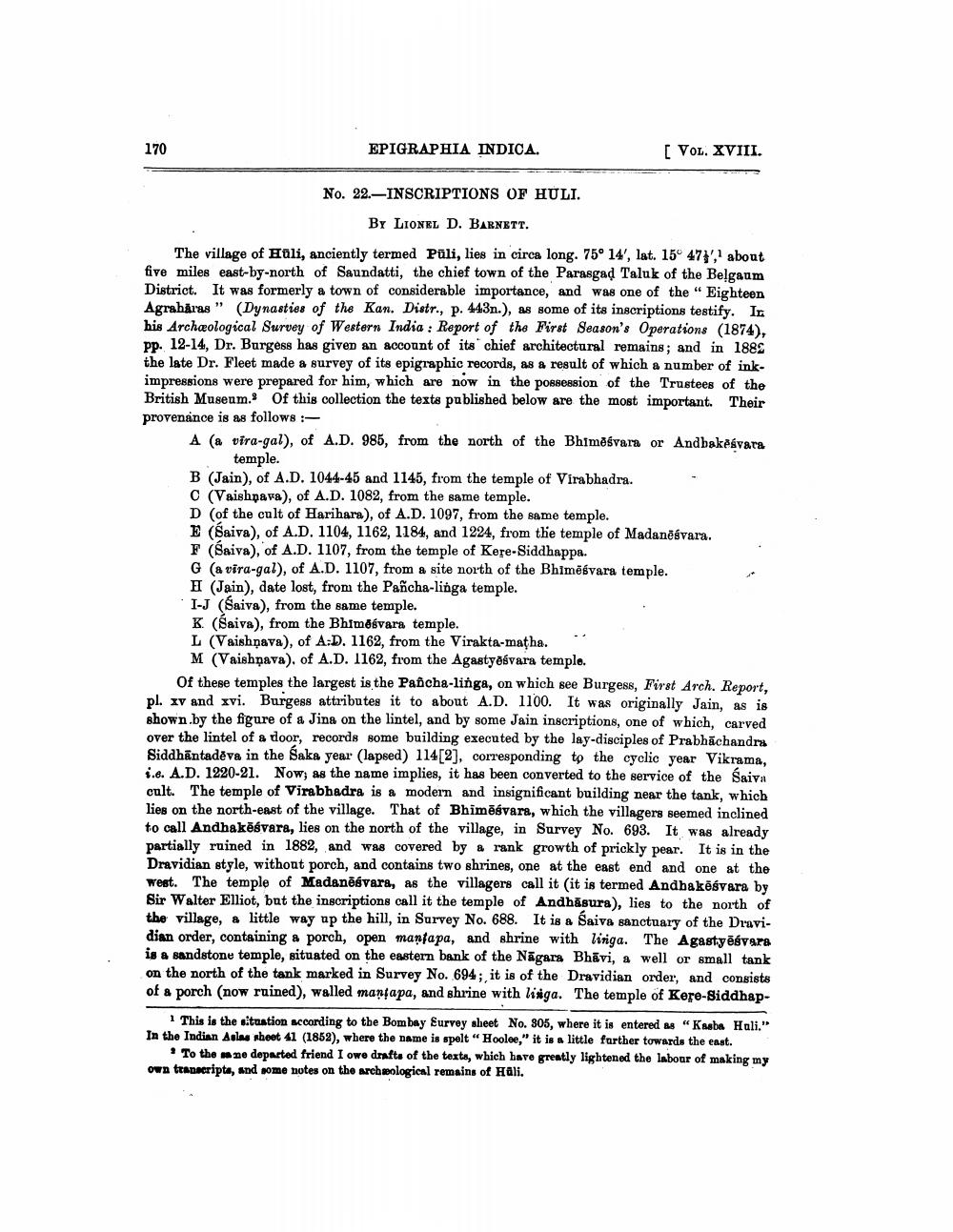________________
170
EPIGRAPHIA INDICA.
[ VOL. XVIII.
No. 22-INSCRIPTIONS OF HULI.
BY LIONEL D. BARNETT. The village of Hali, anciently termed Pūli, lies in circa long. 75° 14', lat. 15° 47}', about five miles east-by-north of Saundatti, the chief town of the Parasgad Taluk of the Belgaum District. It was formerly a town of considerable importance, and was one of the "Eighteen Agraharas” (Dynasties of the Kan. Distr., p. 443n.), as some of its inscriptions testify. In his Archæological Survey of Western India : Report of the First Season's Operations (1874), Pp. 12-14, Dr. Burgess has given an account of its chief architectural remains; and in 1889 the late Dr. Fleet made a survey of its epigraphic records, as a result of which a number of ink. impressions were prepared for him, which are now in the possession of the Trustees of the British Museum. Of this collection the texts published below are the most important. Their provenance is as follows: A (a vira-gal), of A.D. 985, from the north of the Bhiměśvara or Andbakesvara
temple. B (Jain), of A.D. 1044-45 and 1145, from the temple of Virabhadra. 0 (Vaishpava), of A.D. 1082, from the same temple. D (of the cult of Harihara), of A.D. 1097, from the same temple. E (Saiva), of A.D. 1104, 1162, 1184, and 1224, from the temple of Madanēsvara. F (Saiva), of A.D. 1107, from the temple of Kere-Siddhappa. G (a vira-gal), of A.D. 1107, from a site north of the Bhimēsvara temple. H (Jain), date lost, from the Pancha-linga temple. I-J (Saiva), from the same temple. K. (saiva), from the Bhimavara temple. L (Vaishnava), of A:D. 1162, from the Virakta-matha. ***
M (Vaishnava) of A.D. 1162, from the Agastyasvara temple.
Of these temples the largest is the Pancha-linga, on which see Burgess, First Arch. Report, pl. xv and xvi. Burgess attributes it to about A.D. 1100. It was originally Jain, as is shown.by the figure of a Jing on the lintel, and by some Jain inscriptions, one of which, carved over the lintel of a door, records some building executed by the lay-disciples of Prabhāchandra Siddhāntadēva in the Saka year (lapsed) 114[2], corresponding to the cyclic year Vikrama, i... A.D. 1220-21. Now, as the name implies, it has been converted to the service of the Saiva cult. The temple of Virabhadra is a modern and insignificant building near the tank, which lies on the north-east of the village. That of Bhimēśvara, which the villagers seemed inclined to call Andhakēsvara, lies on the north of the village, in Survey No. 693. It was already partially ruined in 1882, and was covered by a rank growth of prickly pear. It is in the Dravidian style, without porch, and contains two shrines, one at the east end and one at the West. The temple of Madanēsvara, as the villagers call it (it is termed Andhakësvara by Sir Walter Elliot, but the inscriptions call it the temple of Andhăsura), lies to the north of the village, a little way up the hill, in Survey No. 688. It is a Saiva sanctuary of the Dravidian order, containing a porch, open mantapa, and shrine with litiga. The Agastyēsvara is a sandstone temple, situated on the eastern bank of the Nāgara Bhāvi, a well or small tank on the north of the tank marked in Survey No. 694;, it is of the Dravidian order, and consists of a porch now ruined), walled mantapa, and shrine with linga. The temple of Kere-Siddhap
wacha,
This is the situation according to the Bombay Survey sheet No. 805, where it is entered as "Kaaba Hali." In the Indian Asla thoot 41 (1859), where the name is spelt“ Hoole," it is a little further towards the east.
* To the ne departed friend I owe drafts of the texts, which have greatly lightened the labour of making my own transcripta, and some notes on the archeological remains of Hali.




